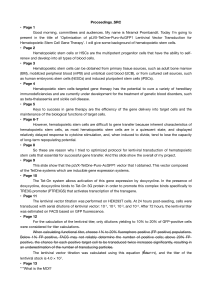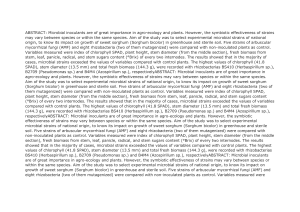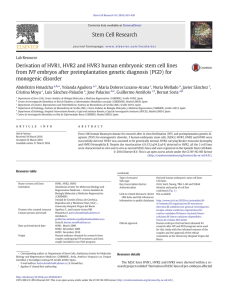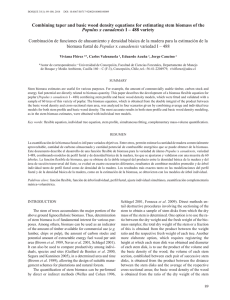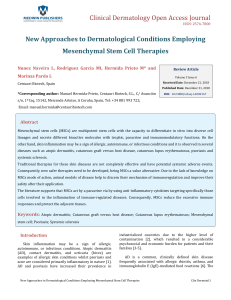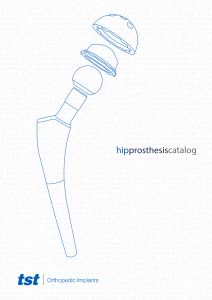Death
Anuncio
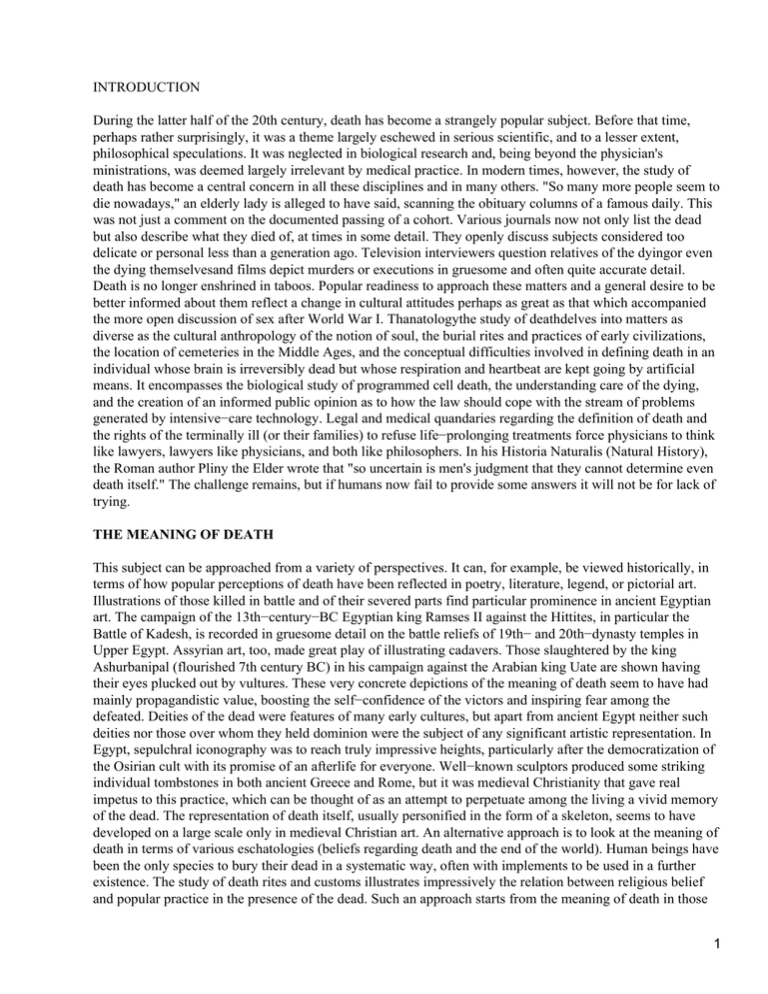
INTRODUCTION During the latter half of the 20th century, death has become a strangely popular subject. Before that time, perhaps rather surprisingly, it was a theme largely eschewed in serious scientific, and to a lesser extent, philosophical speculations. It was neglected in biological research and, being beyond the physician's ministrations, was deemed largely irrelevant by medical practice. In modern times, however, the study of death has become a central concern in all these disciplines and in many others. "So many more people seem to die nowadays," an elderly lady is alleged to have said, scanning the obituary columns of a famous daily. This was not just a comment on the documented passing of a cohort. Various journals now not only list the dead but also describe what they died of, at times in some detail. They openly discuss subjects considered too delicate or personal less than a generation ago. Television interviewers question relatives of the dyingor even the dying themselvesand films depict murders or executions in gruesome and often quite accurate detail. Death is no longer enshrined in taboos. Popular readiness to approach these matters and a general desire to be better informed about them reflect a change in cultural attitudes perhaps as great as that which accompanied the more open discussion of sex after World War I. Thanatologythe study of deathdelves into matters as diverse as the cultural anthropology of the notion of soul, the burial rites and practices of early civilizations, the location of cemeteries in the Middle Ages, and the conceptual difficulties involved in defining death in an individual whose brain is irreversibly dead but whose respiration and heartbeat are kept going by artificial means. It encompasses the biological study of programmed cell death, the understanding care of the dying, and the creation of an informed public opinion as to how the law should cope with the stream of problems generated by intensive−care technology. Legal and medical quandaries regarding the definition of death and the rights of the terminally ill (or their families) to refuse life−prolonging treatments force physicians to think like lawyers, lawyers like physicians, and both like philosophers. In his Historia Naturalis (Natural History), the Roman author Pliny the Elder wrote that "so uncertain is men's judgment that they cannot determine even death itself." The challenge remains, but if humans now fail to provide some answers it will not be for lack of trying. THE MEANING OF DEATH This subject can be approached from a variety of perspectives. It can, for example, be viewed historically, in terms of how popular perceptions of death have been reflected in poetry, literature, legend, or pictorial art. Illustrations of those killed in battle and of their severed parts find particular prominence in ancient Egyptian art. The campaign of the 13th−century−BC Egyptian king Ramses II against the Hittites, in particular the Battle of Kadesh, is recorded in gruesome detail on the battle reliefs of 19th− and 20th−dynasty temples in Upper Egypt. Assyrian art, too, made great play of illustrating cadavers. Those slaughtered by the king Ashurbanipal (flourished 7th century BC) in his campaign against the Arabian king Uate are shown having their eyes plucked out by vultures. These very concrete depictions of the meaning of death seem to have had mainly propagandistic value, boosting the self−confidence of the victors and inspiring fear among the defeated. Deities of the dead were features of many early cultures, but apart from ancient Egypt neither such deities nor those over whom they held dominion were the subject of any significant artistic representation. In Egypt, sepulchral iconography was to reach truly impressive heights, particularly after the democratization of the Osirian cult with its promise of an afterlife for everyone. Well−known sculptors produced some striking individual tombstones in both ancient Greece and Rome, but it was medieval Christianity that gave real impetus to this practice, which can be thought of as an attempt to perpetuate among the living a vivid memory of the dead. The representation of death itself, usually personified in the form of a skeleton, seems to have developed on a large scale only in medieval Christian art. An alternative approach is to look at the meaning of death in terms of various eschatologies (beliefs regarding death and the end of the world). Human beings have been the only species to bury their dead in a systematic way, often with implements to be used in a further existence. The study of death rites and customs illustrates impressively the relation between religious belief and popular practice in the presence of the dead. Such an approach starts from the meaning of death in those 1 cultures (such as Phoenician, early Judaic, Homeric, Epicurean, and Stoic) in which only a shadowy afterlife or no afterlife at all was envisaged; it analyzes other traditions (such as Sumero−Akkadian) in which ambiguities and contradictions abounded; and it finally searches for death's meaning in those cultures (such as ancient Egyptian, Zoroastrian, Hindu, Orphic, Platonic, Christian, Pharisaic Judaic, and Isl?mic) in which a very "physical" afterlife, or the presence of an eternal soul, played central roles. Both the historical and the eschatological approaches share a common advantage: they need not be preceded by a definition of death. They accept death as an easily determined empirical fact, not requiring discussion or further elaboration. But a conceptual crisis has arisen in modern medicine and biology, a crisis that stems precisely from the realization that the definition of deathtaken for granted for millenniarequires reexamination. To approach the subject of death from the biological angle, which is perhaps the most difficult and arguably the most challenging perspective, certainly reflects some of the most pressing needs of modern times. Many dictionaries define death as "the extinction or cessation of life" or as "ceasing to be." As life itself is notoriously difficult to defineand as everyone tends to think of things in terms of what is knownthe problems in defining death are immediately apparent. The most useful definitions of life are those that stress function, whether at the level of physiology, of molecular biology and biochemistry, or of genetic potential. Death should be thought of as the irreversible loss of such functions. The remainder of this article first explores the recurrent problems involved in seeking a biological definition of death. It then examines the implications of these problems in relation to human death. In this context, the article raises two major points: (1) death of the brain is the necessary and sufficient condition for death of the individual; and (2) the physiological core of brain death is the death of the brain stem. Finally, the article surveys notions about the meaning of human death that have prevailed throughout history in a wide variety of cultural contexts. By so doing, it attempts to show that brain−stem death, far from being a radically new idea, turns out to have always provided both an ultimate mechanism of death and a satisfactory anatomical basis for a wide range of philosophical concepts relating to death. THE BIOLOGICAL PROBLEMSWhether one considers the death of individual cells, the death of small multicellular organisms, or the death of a human being, certain problems are repeatedly met. The physicist may encounter difficulties in trying to define death in terms of entropy change and the second law of thermodynamics. So may the histologist looking at the ultrastructure of dying tissue through an electron microscope. Pope Pius XII, speaking to an International Congress of Anesthesiologists in 1957, raised the question of when, in the intensive care unit, the soul actually left the body. More secularly inclined philosophers have meanwhile pondered what it was that was so essential to the nature of man that its loss should be called death. The questions of what may or may not be legitimately demanded of a "beating−heart cadaver" (in terms of supplying donor organs for transplants or of serving as a subject for physiological experimentation) has given new poignancy to the quip made by the English author Sir Thomas Browne in 1643: "With what strife and pains we come into the world we know not, but 'tis commonly no easy matter to get out of it." Common conceptual difficulties underlie many of these questions. DEATH: PROCESS OR EVENT. The American physician and writer Oliver Wendell Holmes said "to live is to function" and "that is all there is in living." But who or what is the subject who lives because it functions? Is death the irreversible loss of function of the whole organism (or cell); that is, of every one of its component parts? Or is it the irreversible loss of function of the organism (or cell) as a whole; that is, as a meaningful and independent biological unit? To perceive the difference between the two questions is to understand many modern controversies about death. The described dichotomy is clearly part of a much wider one: civilizations fall apart yet their component societies live on; societies disintegrate but their citizens survive; individuals die while their cells, perversely, still metabolize; finally, cells can be disrupted yet the enzymes they release may, for a while, remain active. Such problems would not arise if nature were tidier. In nearly all circumstances human death is a process rather than an event. Unless caught up in nuclear explosions people do not die suddenly, like the bursting of a bubble. A quiet, "classical" death provides perhaps the best illustration of death as a process. Several minutes after the heart has stopped beating, a mini−electrocardiogram may be recorded, if one probes for signals from within the cardiac cavity. Three hours later, the pupils still respond to pilocarpine drops by contracting, and muscles repeatedly tapped may still mechanically shorten. A viable skin graft may be 2 obtained from the deceased 24 hours after the heart has stopped, a viable bone graft 48 hours later, and a viable arterial graft as late as 72 hours after the onset of irreversible asystole (cardiac stoppage). Cells clearly differ widely in their ability to withstand the deprivation of oxygen supply that follows arrest of the circulation. Similar problems arise, but on a vastly larger scale, when the brain is dead but the heart (and other organs) are kept going artificially. Under such circumstances, it can be argued, the organism as a whole may be deemed dead, although the majority of its cells are still alive. THE "POINT OF NO RETURN." To claim that death is a process does not imply that this process unfurls at an even rate, or that within it there are not "points of no return." The challenge is to identify such points with greater precision for various biological systems. At the clinical level, the irreversible cessation of circulation has for centuries been considered a point of no return. It has provided (and still provides) a practical and valid criterion of irreversible loss of function of the organism as a whole. What is new is the dawning awareness that circulatory arrest is a mechanism of death and not in itself a philosophical concept of death; that cessation of the heartbeat is only lethal if it lasts long enough to cause critical centres in the brain stem to die; and that this is so because the brain stem is irreplaceable in a way the cardiac pump is not. These are not so much new facts as new ways of looking at old ones. Failure to establish beyond all doubt that the point of no return had been reached has, throughout the ages, had interesting effects on medical practice. The Thracians, according to the ancient Greek historian Herodotus, kept their dead for three days before burial. The Romans kept the corpse considerably longer; the Roman author Servius, in his commentary on Virgil, records that "on the eighth day they burned the body and on the ninth put its ashes in the grave." The practice of cutting off a finger, to see whether the stump bled, was often resorted to. Even the most eminent proved liable to diagnostic error. The 16th−century Flemish physician Andreas Vesalius, probably the greatest anatomist of all time, professor of surgery in Padua for three years and later physician to the Holy Roman emperor Charles V, had to leave Spain in a hurry in 1564. He was performing a postmortem when the subject, a nobleman he had been attending, showed signs of life. This was at the height of the Spanish Inquisition and Vesalius was pardoned only on the condition that he undertake a pilgrimage to the Holy Sepulchre in Jerusalem. Fears of being buried alive have long haunted humankind. During the 19th century, for example, accounts of "live sepulture" appeared in medical writing and led to repeated demands that putrefactionthe only sure sign of death of the whole organismbe considered an essential prerequisite to a diagnosis of death. Anxieties had become so widespread following the publication of some of U.S. author Edgar Allan Poe's macabre short stories that Count Karnice−Karnicke, a Russian nobleman, patented a coffin of particular type. If the "corpse" regained consciousness after burial, it could summon help from the surface by activating a system of flags and bells. Advertisements described the price of the apparatus as "exceedingly reasonable, only about twelve shillings." At the turn of the century, a sensation−mongering press alleged that there were "many ugly secrets locked up underground." There may have been some basis for these claims: instances of collapse and apparent death were not uncommon during epidemics of plague, cholera, and smallpox; hospitals and mortuaries were overcrowded, and there was great fear of the spread of infection. This agitation resulted in stricter rules concerning death certification. In the United Kingdom, statutory obligations to register deaths date only from 1874, and at that time it was not even necessary for a doctor to have viewed the corpse. The second half of the 20th century has seen tremendous developments in the field of intensive care and the emergence of new controversies concerning the point of no return. Modern technology now makes it possible to maintain ventilation (by respirators), cardiac function (by various pumping devices), feeding (by the intravenous route), and the elimination of the waste products of metabolism (by dialysis) in a body whose brain is irreversibly dead. In these macabre by−products of modern technology, a dissociation has taken place between the various components of death so that the most importantthe death of the brainoccurs before, rather than after, the cessation of other functions, such as circulation. Such cases have presented both practical and conceptual problems, but the latter need not have arisen had what happens during decapitation been better appreciated. "Beating−heart cadavers" were of course familiar to the observant long before the days of intensive care units. A photograph of a public decapitation in a Bangkok square in the mid−1930s illustrates such a case. The victim is tied to a stake and the head has been severed, but jets of blood from the carotid and vertebral arteries 3 in the neck show that the heart is still beating. It is doubtful that anyone would describe the executed manas distinct from some of his organsas still alive. This gruesome example stresses three points: it reiterates the fact, admittedly from an unusual angle, that death is a process rather than an event; it emphasizes the fact that in this process there is a point of no return; and it graphically illustrates the difference between the death of the organism as a whole and the death of the whole organism. In thinking the implications through, one takes the first steps toward understanding brain death. The executed man has undergone anatomical decapitation. Brain death is physiological decapitation: it arises when intracranial pressure exceeds arterial pressure, thereby depriving the brain of its blood supply as efficiently as if the head had been cut off. The example serves as an introduction to the proposition that the death of the brain is the necessary and sufficient condition for the death of the individual. These issues were authoritatively discussed in 1968, at the 22nd World Medical Assembly in Sydney, Australia. The assembly stated that "clinical interest lies not in the state of preservation of isolated cells but in the fate of a person. The point of death of the different cells and organs is not as important as the certainty that the process has become irreversible." The statement had a profound effect on modern medical thinking. "Irreversible loss of function of the organism as a whole" became an accepted clinical criterion of death. Semantic confusion may underlie some of the controversies outlined in this section. In many languages, including English, the word death may be used in various ways. The Concise Oxford Dictionary for instance defines death both as "dying" (a process) and as "being dead" (a state). Expressions such as "a painful death" and "a lingering death" show how often the word is used in the former sense. Many people are afraid of dying yet can face the prospect of being dead with equanimity. Another source of confusion that bedevils discussions about death is what the great English mathematician and philosopher Alfred North Whitehead called the "fallacy of misplaced concreteness." This occurs when one treats an abstraction (however useful it may be to denote the behaviour or properties of objects under specific circumstances) as if it were itself a material thing. "O death, where is thy sting?" may be a searching metaphorical question, but such queries can only confuse the biologist. When the poet John Milton wrote of "the pain of death denounced, whatever thing death be," the conceptual problem was of his own making. The next two sections of this article illustrate these general principles concerning death from each end of the spectrum of living things: from the level of the cell and from that of the fully developed human being. CELL DEATH A vast amount of work has been devoted since the late 19th century to discovering how cells multiply. The study of how and why they die is a relatively recent concern: a rubric entitled "cell death" only appeared in the Index Medicus, an index to medical literature, in 1979. What most textbooks of pathology describe as cell death is coagulative necrosis. This is an abnormal morphological appearance, detected in tissue examined under the microscope. The changes, which affect aggregates of adjacent cells or functionally related cohorts of cells, are seen in a variety of contexts produced by accident, injury, or disease. Among the environmental perturbations that may cause cell necrosis are oxygen deprivation (anoxia), hyperthermia, immunological attack, and exposure to various toxins that inhibit crucial intracellular metabolic processes. Coagulative necrosis is the classical form of cell change seen when tissues autolyze (digest themselves) in vitro. But cells may die by design as well as by accident. Research in developmental pathology has stressed the biological importance of this other kind of cell death, which has been referred to as programmed cell death. In vertebrates it has been called apoptosis and in invertebrates, cell deletion. Programmed cell death plays an important role in vertebrate ontogeny (embryological development) and teratogenesis (the production of malformations), as well as in the spectacular metamorphoses that affect tadpoles or caterpillars. Such programmed events are essential if the organism as a whole is to develop its normal final form. Waves of genetically driven cell death are critical to the proper modeling of organs and systems. The inflections (curvatures) of the developing mammalian brain and spinal cord, for instance, or the achievement of a proper numerical balance between functionally related cell groups, cannot be understood without an appreciation of how the death of some (or many) cells is necessary for others to reach maturity. Localized cell death, occurring at precise moments during normal ontogeny, explains phenomena as varied as the fashioning of the digits or the involution of phylogenetic vestiges. Several congenital abnormalities can be attributed to disorders of programmed cell death. Cell death occurs spontaneously in normally involuting tissues such as 4 the thymus. It can be initiated or inhibited by a variety of environmental stimuli, both physiological and pathological. Cell death even occurs in some of the cells of untreated malignant tumours, and it is seen during tumour regression induced by X rays or radiomimetic cytotoxic agents. Programmed cell death may also play a part in the process of aging, cells being designed to die after a certain number of mitotic divisions. Groups of cells responsible for the colour of human hair, for instance, may cease to function years before the hair itself loses the capacity to grow: the result is the "uncoloured" white hair of old age. The two types of cell deathimposed from without or programmed from withinhave different morphological features. Furthermore, different intracellular mechanisms have been incriminated in their production. Necrosis is characterized by early swelling of the cytoplasm and of the mitochondria (energy−releasing organelles) within it. Later changes include the appearance of localized densities, possibly related to calcium deposition, in the matrix (ground substance) of the mitochondria. This is followed by the dissolution of other cytoplasmic organelles and the separation of affected cells from their neighbours through shearing of intercellular junctions. Nuclear alterations occur late and are relatively unremarkable. The nucleus swells, becomes darker (pyknosis), and ruptures (karyolysis) at about the same time as does the plasma membrane, the outer envelope of the cell. The basic mechanism of necrosis is thought to be a loss of control over cell volume, related to changes in the permeability of the cell membrane. These changes form the basis of several of the tests used to diagnose a necrotic cell in the laboratory. The affected membrane rapidly loses its ion−pumping capacity, and there are dramatic increases in the intracellular concentrations of sodium and calcium ions. This is followed by osmotic shock and the development of intracellular acidosis. The early injury to the mitochondria has profound repercussions on intracellular oxidative metabolism. The point of no return is reached with irreversible damage to mitochondrial structure and function. Later still, the lysosomes (membranous bags of hydrolytic enzymes found in most cells) rupture, releasing their acid enzymes into the cytoplasm of the cell. All this produces an ionic milieu unsuitable to the survival of the nucleus. Loss of the cell's capacity to synthesize protein is the ultimate proof that it is functionally dead. Programmed cell death usually affects scattered single cells. Early ultrastructural features are the disintegration of cell junctions and condensations of the cytoplasm. The cells shrivel up instead of swelling. Lumps of chromatin aggregate at the surface of the nucleus. The nuclear membrane develops folds, and the nucleus splits into a number of membrane−bound, ultrastructurally well−preserved fragments, which are shed and promptly taken up by specialized scavenger cells or even by ordinary cells in the neighbourhood. Energy−producing mitochondria are preserved until quite late. The nuclear changes seem to be energy−dependent; they may reflect the fact that genes in the nucleus are beginning to express themselves in new ways, in response to unknown stimuli. One of these responses seems to be the activation of endogenous endonucleases, enzymes in the cell nucleus that "suicidally" disrupt its cardinal functions. Time alone will tell whether the distinctions between the two types of cell death are valid or spurious, and whether the concept of apoptosis will gain wide acceptance. Reality will probably turn out to be a great deal more complex. Meanwhile, one should retain, without overemphasis, the twin visions of cell deathone in which death approaches the cell from the outside and the other in which death starts from within the living core of the cell itself. CLINICAL DEATHAt the opposite end of the spectrum from cell death lies the death of a human being. It is obvious that the problems of defining human death cannot be resolved in purely biological terms, divorced from all ethical or cultural considerations. This is because there will be repercussions (burial, mourning, inheritance, etc.) from any decisions made, and because the decisions themselves will have to be socially acceptable in a way that does not apply to the fate of cells in tissue culture. Unless death is defined at least in outline, the decision that a person is "dead" cannot be verified by any amount of scientific investigation. Technical data can never answer purely conceptual questions. Earlier in this article it was suggested that the death of the brain was the necessary and sufficient condition for the death of the individual, but the word death was not given much content beyond the very general definition of "irreversible loss of function." If one seeks to marry conceptions of death prevalent in the oldest cultures with the most up−to−date observations from intensive care units, one might think of human death as the irreversible loss of the capacity for consciousness combined with the irreversible loss of the capacity to breathe. The anatomical basis for such a concept of human death resides in the loss of brain−stem function. FUNCTIONS OF THE BRAIN STEM. 5 The brain stem is the area at the base of the brain that includes the mesencephalon (midbrain), the pons, and the medulla. It contains the respiratory and vasomotor centres, which are responsible, respectively, for breathing and the maintenance of blood pressure. Most importantly, it also contains the ascending reticular activating system, which plays a crucial role in maintaining alertness (i.e., in generating the capacity for consciousness); small, strategically situated lesions in the medial tegmental portions of the midbrain and rostral pons cause permanent coma. All of the motor outputs from the cerebral hemispheresfor example, those that mediate movement or speechare routed through the brain stem, as are the sympathetic and parasympathetic efferent nerve fibres responsible for the integrated functioning of the organism as a whole. Most sensory inputs also travel through the brain stem. This part of the brain is, in fact, so tightly packed with important structures that small lesions there often have devastating effects. By testing various brain−stem reflexes, moreover, the functions of the brain stem can be assessed clinically with an ease, thoroughness, and degree of detail not possible for any other part of the central nervous system. It must be stressed that the capacity for consciousness (an upper brain−stem function) is not the same as the content of consciousness (a function of the cerebral hemispheres); it is, rather, an essential precondition of the latter. If there is no functioning brain stem, there can be no meaningful or integrated activity of the cerebral hemispheres, no cognitive or affective life, no thoughts or feelings, no social interaction with the environment, nothing that might legitimize adding the adjective sapiens ("wise") to the noun Homo ("man"). The "capacity for consciousness" is perhaps the nearest one can get to giving a biological flavour to the notion of "soul." The capacity to breathe is also a brain−stem function, and apnea (respiratory paralysis) is a crucial manifestation of a nonfunctioning lower brain stem. Alone, of course, it does not imply death; patients with bulbar poliomyelitis, who may have apnea of brain−stem origin, are clearly not dead. Although irreversible apnea has no strictly philosophical dimension, it is useful to include it in any concept of death. This is because of its obvious relation to cardiac functionif spontaneous breathing is lost the heart cannot long continue to functionand perhaps because of its cultural associations with the "breath of life." These aspects are addressed in the later discussion of how death has been envisaged in various cultures. MECHANISMS OF BRAIN−STEM DEATH. From as far back as medical records have been kept, it has been known that patients with severe head injuries or massive intracranial hemorrhage often die as a result of apnea: breathing stops before the heart does. In such cases, the pressure in the main (supratentorial) compartment of the skull becomes so great that brain tissue herniates through the tentorial opening, a bony and fibrous ring in the membrane that separates the spaces containing the cerebral hemispheres and the cerebellum. The brain stem runs through this opening, and a pressure cone formed by the herniated brain tissue may dislocate the brain stem downward and cause irreversible damage by squeezing it from each side. An early manifestation of such an event is a disturbance of consciousness; a late feature is permanent apnea. This was previously nature's way out. With the widespread development of intensive care facilities in the 1950s and '60s, more and more such moribund patients were rushed to specialized units and put on ventilators just before spontaneous breathing ceased. In some cases the effect was dramatic. When a blood clot could be evacuated, the primary brain damage and the pressure cone it had caused might prove reversible. Spontaneous breathing would return. In many cases, however, the massive, structural intracranial pathology was irremediable. The ventilator, which had taken over the functions of the paralyzed respiratory centre, enabled oxygenated blood to be delivered to the heart, which went on beating. Physicians were caught up in a therapeutic dilemma partly of their own making: the heart was pumping blood to a dead brain. Sometimes the intracranial pressure was so high that the blood could not even enter the head. Modern technology was exacting a very high price: the beating−heart cadaver. Brain−stem death may also arise as an intracranial consequence of extracranial events. The main cause in such cases is circulatory arrest. The usual context is delayed or inadequate cardiopulmonary resuscitation following a heart attack. The intracranial repercussions depend on the duration and severity of impaired blood flow to the head. In the 1930s the British physiologist John Scott Haldane had emphasized that oxygen deprivation "not only stopped the machine, but wrecked the machinery." Circulatory arrest lasting two or three minutes can cause widespread and irreversible damage to the cerebral hemispheres while sparing the brain stem, which is more resistant to anoxia. Such patients remain in a "persistent vegetative state." They breathe and swallow 6 spontaneously, grimace in response to pain, and are clinically and electrophysiologically awake, but they show no behavioral evidence of awareness. Their eyes are episodically open (so that the term coma is inappropriate to describe them), but their retained capacity for consciousness is not endowed with any content. Some patients have remained like this for many years. Such patients are not dead, and their prognosis depends in large part on the quality of the care they receive. The discussion of their management occasionally abuts onto controversies about euthanasia and the "right to die." These issues are quite different from that of the "determination of death," and failure to distinguish these matters has been the source of great confusion. If circulatory arrest lasts for more than a few minutes, thebrain stemincluding its respiratory centrewill be as severely damaged as the cerebral hemispheres. Both the capacity for consciousness and the capacity to breathe will be irreversibly lost. The individual will then show all the clinical features of a dead brain, even if the heart can be restarted. EVOLUTION OF THE CONCEPT OF BRAIN−STEM DEATH. It was against this sort of background that French neurologists, in 1958, described a condition they called coma dépassé (literally, "a state beyond coma"). Their patients all had primary, irremediable, structural brain lesions; were deeply comatose; and were incapable of spontaneous breathing. They had not only lost their ability to react to the external world, but they also could no longer control their own internal environment. They became poikilothermic (i.e., they could not control their body temperature, which varied with that of the environment). They could not control their blood pressure or vary their heart rate in response to appropriate stimuli. They could not even retain body water and would pass great volumes of urine. The organism as a whole had clearly ceased to function. Coma dépassé was considered a "frontier state" between life and death. Ventilation was continued in the vast majority of such cases until the heartbeat ceased, usually a few days later. In 1968 the Ad Hoc Committee of the Harvard Medical School published a report entitled "A Definition of Irreversible Coma" in The Journal of the American Medical Association. This watershed article listed criteria for the recognition of the "brain−death syndrome." It stated that the persistence of a state of apneic coma with no evidence of brain−stem and spinal reflexes and a flat electroencephalogram over a period of 24 hours implied brain death, provided the cause of the coma was known and provided reversible causes of brain dysfunction (such as hypothermia or drug intoxication) had been excluded. The report explicitly identified brain death with death (without seeking to define death) and endorsed the withdrawal of respiratory support in such cases. No evidence was published to legitimize the contention that the coma was irreversible; i.e., that if artificial ventilation was continued no such patient ever recovered consciousness, and that all invariably developed asystole. There was wide medical experience among the members of the committee, however, and its contentions have since been massively validated. Not a single exception has come to light. The next few years witnessed increasing sophistication in the techniques used to diagnose brain death, none of which, however, surpassed basic clinical assessment. In 1973 two neurosurgeons in Minneapolis, Minn., identified the death of the brain stem as the point of no return in the diagnosis of brain death. In 1976 and 1979, the Conference of Royal Colleges and Faculties of the United Kingdom published important memoranda on the subject. The first described the clinical features of a dead brain stem, the second identified brain−stem death with death. In 1981 in the United States, the President's Commission for the Study of Ethical Problems in Medicine and Biomedical and Behavioral Research published a report ("Defining Death") and a list of guidelines very similar to the British ones. The commission also proposed a model statute, called the Uniform Determination of Death Act, which was subsequently endorsed by the American Medical Association, the American Bar Association, and the National Conference of Commissioners on Uniform State Laws and became law in many states. International opinion and practice has moved along similar lines in accepting the concept of brain−stem death. DIAGNOSIS OF BRAIN−STEM DEATH. The diagnosis is not technically difficult. In more and more countries, it is made on purely clinical grounds. The aim of the clinical tests is not to probe every neuron within the intracranial cavity to see if it is deadan impossible taskbut to establish irreversible loss of brain−stem function. This is the necessary and sufficient condition for irreversible unconsciousness and irreversible apnea, which together spell a dead patient. Experience has shown that instrumental procedures (such as electroencephalography and studies of cerebral 7 blood flow) that seek to establish widespread loss of cortical function contribute nothing of relevance concerning the cardiac prognosis. Such tests yield answers of dubious reliability to what are widely felt to be the wrong questions. As the concept of brain−stem death is relatively new, most countries rightly insist that the relevant examinations be carried out by physicians of appropriate seniority. These doctors (usually neurologists, anesthetists, or specialists in intensive care) must be entirely separate from any who might be involved in using the patient's organs for subsequent transplants. The diagnosis of brain−stem death involves three stages. First, the cause of the coma must be ascertained, and it must be established that the patient (who will always have been in apneic coma and on a ventilator for several hours) is suffering from irremediable, structural brain damage. Damage is judged "irremediable" based on its context, the passage of time, and the failure of all attempts to remedy it. Second, all possible causes of reversible brain−stem dysfunction, such as hypothermia, drug intoxication, or severe metabolic upset, must be excluded. Finally, the absence of all brain−stem reflexes must be demonstrated, and the fact that the patient cannot breathe, however strong the stimulus, must be confirmed. It may take up to 48 hours to establish that the preconditions and exclusions have been met; the testing of brain−stem function takes less than half an hour. When testing the brain−stem reflexes, doctors check for the following normal responses: (1) constriction of the pupils in response to light, (2) blinking in response to stimulation of the cornea, (3) grimacing in response to firm pressure applied just above the eye socket, (4) movements of the eyes in response to the ears being flushed with ice water, and (5) coughing or gagging in response to a suction catheter being passed down the airway. All responses have to be absent on at least two occasions. Apnea, which also must be confirmed twice, is assessed by disconnecting the patient from the ventilator. (Prior to this test, the patient is fully oxygenated by being made to breathe 100 percent oxygen for several minutes, and diffusion oxygenation into the trachea is maintained throughout the procedure. These precautions ensure that the patient will not suffer serious oxygen deprivation while disconnected from the ventilator.) The purpose of this test is to establish the total absence of any inspiratory effort as the carbon dioxide concentration in the blood (the normal stimulus to breathing) reaches levels more than sufficient to drive any respiratory centre cells that may still be alive. The patient thus passes through a tight double filter of preconditions and exclusions before he is even tested for the presence of a dead brain stem. This emphasis on strict preconditions and exclusions has been a major contribution to the subject of brain−stem death, and it has obviated the need for ancillary investigations. Thousands of patients who have met criteria of this kind have had ventilation maintained: all have developed asystole within a few hours or a few days, and none has ever regained consciousness. There have been no exceptions. The relevant tests for brain−stem death are carried out systematically and without haste. There is no pressure from the transplant team. The developments in the idea and diagnosis of brain−stem death came as a response to a conceptual challenge. Intensive−care technology had saved many lives, but it had also created many brain−dead patients. To grasp the implications of this situation, society in generaland the medical profession in particularwas forced to rethink accepted notions about death itself. The emphasis had to shift from the most common mechanism of death (i.e., irreversible cessation of the circulation) to the results that ensued when that mechanism came into operation: irreversible loss of the capacity for consciousness, combined with irreversible apnea. These results, which can also be produced by primary intracranial catastrophes, provide philosophically sound, ethically acceptable, and clinically applicable secular equivalents to the concepts of "departure of the soul" and "loss of the 'breath of life,' " which were so important to some earlier cultures. DEATH JOSE MANUEL SOTO HIDALGO 1 14 8

